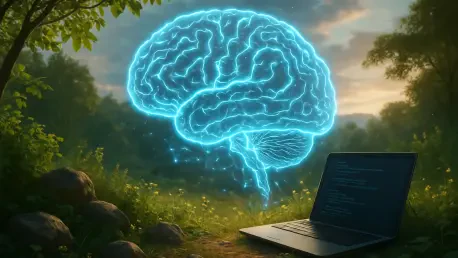Imagine a world where machines not only process data but genuinely reason like humans, solving complex problems with abstract thinking and adaptability, a vision once confined to science fiction but now becoming a tangible reality through groundbreaking advancements in artificial intelligence, particularly in the integration of natural language as a programming paradigm. A recent breakthrough by a leading research scientist has spotlighted this transformative potential, achieving unprecedented success in a challenging AI benchmark. By shifting from traditional coding methods to leveraging the expressive power of human language, this innovation addresses critical gaps in machine reasoning. The implications are profound, promising to redefine how AI systems learn, adapt, and interact with the world. This article delves into the nuances of this pioneering approach, exploring its methodology, the limitations it seeks to overcome, and the ambitious future it envisions for intelligent systems.
Breaking New Ground in AI Challenges
Pioneering Success in ARC-AGI v2
The ARC-AGI v2 challenge, often described as an IQ test for machines, demands abstract pattern recognition to transform input grids into outputs based on hidden rules. A remarkable achievement in this arena has come from a research scientist at Reflection AI, who recently topped the public leaderboard with a score of 29.4%. This success marks a significant leap from previous efforts, showcasing a novel approach that harnesses natural language to program AI systems. Unlike earlier methods that relied heavily on generating code like Python, this strategy uses descriptive language to outline algorithms, allowing for greater flexibility in tackling complex, compositional problems. The winning architecture integrates advanced language models to describe solutions in a human-like manner, prioritizing exploration over rigid iteration. This shift has proven effective in addressing tasks that require multiple interwoven rules, a hurdle that stumped traditional programming methods in the updated challenge.
From Code to Conversation in Problem-Solving
Transitioning from code-based solutions to natural language descriptions represents a paradigm shift in AI development. In earlier iterations of the ARC-AGI challenge, the focus was on generating and refining Python functions through evolutionary computation, achieving notable accuracy. However, as the challenges evolved to include more intricate problems, the limitations of this approach became evident. Natural language emerged as a more adaptable medium, capable of expressing nuanced ideas and facilitating broader exploration of potential solutions. This method leverages the capabilities of cutting-edge models to internally revise and refine strategies, mimicking a conversational approach to problem-solving. By describing algorithms in plain language, AI systems can better navigate the abstract reasoning required for tasks beyond rote data processing. This innovative leap underscores the potential of language as a bridge between human cognition and machine logic, opening new pathways for AI to emulate deeper understanding.
Addressing AI Limitations and Future Visions
Overcoming the Barrier of True Reasoning
One of the most pressing challenges in AI today is the inability of current models to engage in genuine reasoning. Often critiqued as mere “stochastic parrots,” these systems excel at regurgitating training data but falter when tasked with synthesizing new knowledge or grasping abstract concepts. This gap is starkly highlighted in benchmarks like ARC-AGI, where even advanced language models struggle with accuracy rates far below human performance. The shift to natural language programming offers a promising avenue to address this shortfall by enabling AI to describe and adapt solutions dynamically. Instead of being confined to predefined patterns, systems can explore a wider solution space, learning the meta-skill of creating skills. This approach aligns with a growing consensus in the AI community that true intelligence requires moving beyond static learning to dynamic, adaptive synthesis, a critical step toward machines that can think more like humans.
Envisioning Adaptive and General Intelligence
Looking ahead, the vision for AI involves creating systems that not only reason but also retain and build upon knowledge without succumbing to issues like catastrophic forgetting, where new learning erases prior information. The goal is to develop architectures with built-in revision loops that allow for continuous adaptation and deep exploration of complex problems. Within the neuro-symbolic debate, there is optimism that neural networks, equipped with sufficient computational power and innovative frameworks, can mirror biological reasoning processes. Experts believe that over the next decade, from now until around 2035, significant strides will be made in overcoming architectural constraints and memory limitations. This ambitious outlook points to a future where AI achieves general intelligence, rivaling human cognitive abilities and driving unprecedented progress across scientific and societal domains. Such a trajectory hinges on paradigms like natural language programming to unlock these transformative capabilities.
Reflecting on Milestones and Next Steps
Reflecting on past achievements, the journey through the ARC-AGI challenges revealed the immense potential of natural language as a tool for enhancing AI reasoning. The transition from rigid coding to expressive language marked a turning point in addressing abstract thinking shortcomings. Critiques of existing models as lacking depth underscored the urgency of innovative approaches, while optimism about achieving general intelligence within a foreseeable timeframe inspired continued exploration. As this field evolved, the emphasis on adaptability and internal revision processes stood out as a beacon for progress. Moving forward, the focus should be on refining these language-based methods, integrating them into broader AI architectures, and tackling persistent challenges like memory retention. Collaboration across research communities will be vital to test and scale these solutions, ensuring that the next generation of intelligent systems not only mimics but truly understands and reasons through the complexities of the world.









